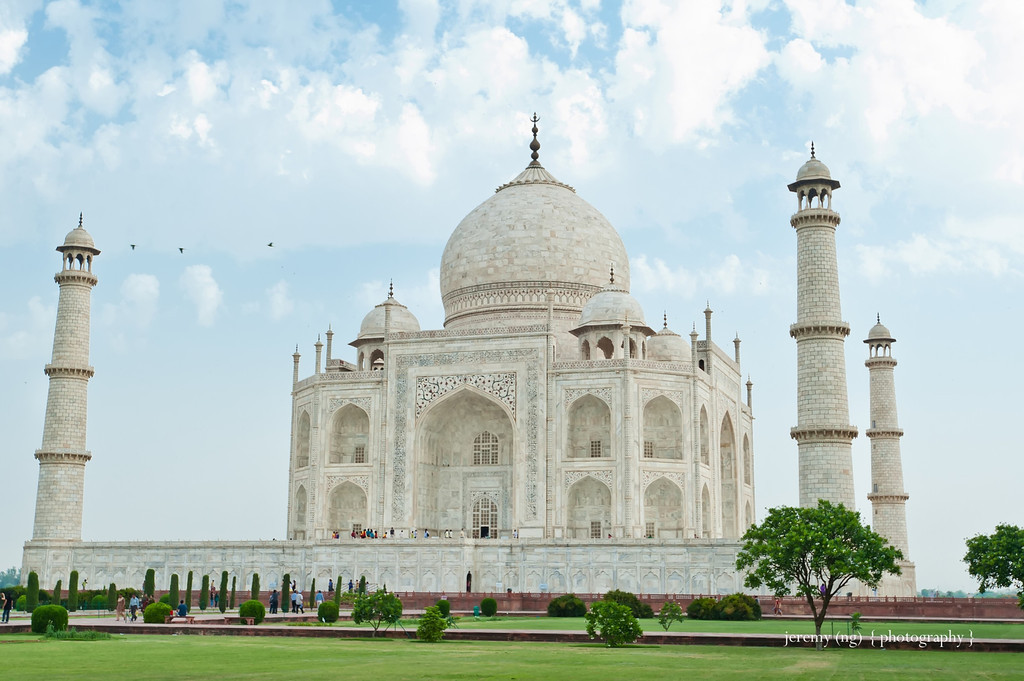We love traveling with our family! This past May, we joined our family on a trip to India. One of the Seven Wonders of the World and a UNESCO heritage site, the Taj Mahal was a “can’t miss” stop on our trip. Taj Mahal is located on the banks of Yamuna River in the city of Agra (northern state of Uttar Pradesh, India). From New Delhi, we were driven to Agra in an air-conditioned Tempo Traveler (arranged via a tour agent). It was a comfortable air-conditioned 4+ hours ride (including lunch and restroom stops) despite the 112 degrees (F) / 44 degrees (C) weather outside! (Note to self: Don’t go to New Delhi early June next time! October, November and February should have milder weather.)
Delhi, India
State Highway 62, Tajganj, Agra, Uttar Pradesh, India
The Story
The Taj Mahal would’ve been “just another tourist attraction” if we had not been told the stories behind the construction of this majestic creation. The marble mausoleum came to life for us when our guide told us the sad fairytale behind this architectural wonder. Knowing the history is an essential part of your experience at the Taj Mahal, so we highly recommend either first reading up about the place, hiring a guide or renting one of the audio guides to fully immerse yourself in the grandeur of this amazing creation!
Queen Mumtaz Mahal (name means Jewel of the Palace) was Emperor Shah Jahan’s (name means King of the World) third wife. She died in labor while giving birth to their 14th child in 1631. The emperor was grief-stricken and inconsolable. Legend has it that he locked himself in his room for two weeks and when he emerged from his room, his hair and beard had turned completely white. He needed spectacles because his eyes had deteriorated from constant weeping. Emperor Shah Jahan gave up listening to music, wearing jewelry or rich and colourful clothes and using perfumes for two years.
He ordered the construction of the Taj Mahal in 1632 to commemorate his love for Mumtaz Mahal and is now the final resting place of both Mumtaz Mahal and Emperor Shah Jahan (their tomb is inside the Taj Mahal). According to our guide, the design of the Taj Mahal and its gardens are representative of paradise as described in the Quran, hence the structure often being referred to as “Paradise on Earth”. A perfectionist, the emperor ensured that every aspect of the Taj Mahal is in perfect symmetry and only the finest materials from around the world were used. You can see from the design details of Taj Mahal (the dome, the minarets and the gardens) that Emperor Shah Jahan had indeed set out to recreate what is heaven right there in Agra.
PHOTOGRAPHY TIP: This shot was taken using a Nikon D700 DSLR along with a Nikkor 16-35mm f/4 Wide Angle lens.
Legend has it that the chief mason, various architects and craftsmen who created the Taj Mahal had their hands amputated so they cannot replicate the Taj Mahal anywhere else in the world.There is no conclusive evidence till today that supports this theory. According to our guide however, it is believed that these artisans were instead made to swear to never leave Agra forever. Till this day, the generations of families from the artisans still live in a community close to the Taj Mahal.
Another sad part of the story was how Emperor Shah Jahan spent the last years of his life. The Taj Mahal took 20,000 workers, 1,000 elephants and 22 years to complete. The emperor had spent so much of the empire’s wealth in building the mausoleum that his son imprisoned his own father so he can take over the reigns and stop his father’s extravagant spending. Emperor Shah Jahan spent the last years of his life, house-arrested in the Agra Fort in a room overlooking the Taj Mahal in the distance until his death at the age of 74.
Breathtaking Marble Marvel
“We were awestruck when we saw the Taj Mahal for the first time.”
Of the many ways it has been described, “a teardrop on the cheek of eternity” (by a famous poet, Tagore) resonates the most with us, especially after learning about the history behind Taj Mahal. Clinton said during his presidential visit to India, “the world is divided into those who have seen the Taj and those who have not”.
We were awestruck when we saw the Taj Mahal for the first time. It gives off an ethereal, tranquil and serene feeling when you look at it. We just couldn’t believe that this structure was hand-built just over 300 years ago! You cannot fully appreciate the breathtaking beauty of the Taj Mahal, the purity of the marble, the exquisite inlay gemstone designs and the love it represents without being there in person. Being in its presence is an out of the world experience everyone should have at least once in his or her lifetime.
TIP: The shots above were also taken using a Nikon D700 DSLR along with a Nikkor 16-35mm Wide Angle lens.
Interesting Facts
We could go on and on about the many interesting stories that the guide had told us but we figured you’d appreciate a summary of the facts that we found most interesting.
- Before entering through the gates to get to the Taj Mahal, there is an old tree that is as old as the Taj Mahal. We were told that the tree had died but was resurrected using chemicals by Japanese scientists!
- The minarets are not perfectly perpendicular to the ground. The smart architects designed it so they are all leaning slightly outward so that in the case of a collapse, the minarets will fall outward and not inward, hence avoid crushing the tomb.
- Everything about the Taj Mahal is symmetric. Even the intricate inlay gemstone designs are symmetric anywhere you look! Imagine building it all in perfect symmetry without the help of modern architectural and design tools! It’s unexplainable how they were able to pull it off!
- The marble used to build the Taj Mahal is called Makrana Marble. It is non-porous and is translucent (so light can shine through it!). It had to be brought to Agra from 250 miles away from the town of Makrana in Rajasthan (remember, they had no trucks and tractors)!
- The inlay work that decorates the Taj Mahal uses precious and semiprecious gemstones that include jasper from Punjab, jade & crystal from China, turquoise from Tibet, Lapis lazuli from Afghanistan, sapphire from Sri Lanka and Carnelianfrom Arabia. In all 28 types of precious stones were inlaid into the white marble.
- Since the Taj Mahal sits on the banks of a river, the foundations were the biggest technical challenge. An ingenious design was put in place whereby wells were sunk and then cased in timber and finally filled with rubble, iron and mortar – essentially acting as augured piles (“screwed in deep foundation” is how I think of it). The interesting part here is that the timber were treated in a way that it will not rot for 800+ years. It has been 300 years. According to our guide, “someone very smart” will have to start thinking about what to do once the timber starts rotting in 500 years time!
- The gardens are known as “char-bargh” (a form of Persian garden divided into four parts). The original gardens actually had “various kinds of fruit-bearing trees and rare aromatic herbs”. It was actually the British, who at the end of the 19th century, turned the gardens into lawns resembling those in London.

- The inscription on the gates through which you’ll see the Taj Mahal says “those of pure heart, mind and soul, you may enter my paradise“.

- As you walk towards the gate to the Taj Mahal, there’s an interesting optical illusion that happens. The Taj Mahal will seem to shrink as you get closer to the gate!
- Shine a flashlight on the Carnelian gemstone (the red gemstone) of the inlay design. It will glow! The other gemstones don’t glow, just the Carnelian.
Photo Tips
- If you stand in the middle of the pathway as you come through the gate to take a picture of the Taj Mahal, it will likely be rather crowded. Walk off to the right of the platform and you’ll still get a beautiful view of the Taj Mahal with less crowds.
- Have some fun when taking photos. Just like at the Leaning Tower of Pisa, you will see people playing with optical illusions. We joined in the fun!
- You can then go to the bottom of the steps and stand in the middle of the start of the fountain to take your centered shot of Taj Mahal!
- Use a wide angle lens when taking pictures of large architecture like Taj Mahal. We used a Nikon D700 DSLR along with a Nikkor 16-35mm f/4 Wide Angle lens.
Have you been to the Taj Mahal or somewhere as breathtaking as the Taj Mahal? Do share your stories!
67 Comments
-
Hi,
I enjoyed your site and wanted to let you know that the 19th edition of the Byteful Travel Blog Carnival will be on JimsGotWeb.com on July 31st. Be sure to go to BlogCarnival.com and submit your travel posts by July 27th to be listed in the Carnival.
I look forward to reading all of your interesting travel articles. See you at the Carnival!
Jim
-
Glad you like the shots we took. Looking forward to reading about your adventures there!
-
Amazing photos guys! We are heading to India in just over 4 weeks for 3 months and after reading your post, even more excited now!
Peter recently posted..Ecotourism and Nature Based Tourism – Do you know the difference?
-
Author
We’re so jealous, Peter! Wished we could go back too! 3 months!!! You’ll have plenty of time to enjoy the sights and sound around India, for sure! Looking forward to reading about your adventures there!
Idelish (Jeremy & Shirlene) recently posted..{Malaysia} Snorkel, Dive and Chill at Redang Island
-
-
It looks like you got some really great pictures of the Taj Mahal! I only got a nice camera recently so my trip to India was with a crappy 4 year old point and shoot camera. Now I need to go back so I can get some good pictures of the Taj, it was so amazing…
Joe recently posted..Get Away With Travalo
-
Author
Thanks Joe! It’s definitely worth a second visit! Thanks for taking the time to drop a comment!
Idelish (Jeremy & Shirlene) recently posted..{USA} Surfing with Goofy Foot Surf School in Maui
-
-
{India} Paradise on Earth, Taj Mahal http://t.co/goAELsR #india #tajMahal #Agra #inspiring #photography
-
Thx for the RT @ExOfficio! Happy friday to u! // Paradise on Earth, Taj Mahal http://bit.ly/maFXvW #India #photography
-
Paradise on Earth, Taj Mahal by @idelishtravel http://bit.ly/maFXvW #India #photography
-
{India} Paradise on Earth, Taj Mahal http://t.co/IBUa7lr via @idelishTravel
-
The Taj is truly a place you need to see with your own eyes. I was fortunate enough to visit in late 2010. I liked the way you captured it with different vantage points and framing.
Nomadic Samuel recently posted..Uyuni Train | Uyuni, Bolivia | Travel Photo
-
Author
Thanks for taking the time to leave a comment! Glad you like the shots we took. Taj Mahal really is an amazing sight that I believe only those who have visited would understand!
Idelish (Jeremy & Shirlene) recently posted..{India} Juleh, the Magic Word in Leh
-


















